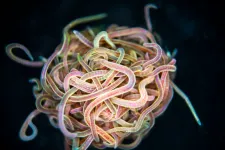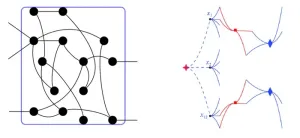(Press-News.org) Engineering a synthetic oscillator that cycles between the two deterioration pathways that lead to cell death can slow aging in yeast cells, increasing their longevity by more than 80%, a new study reports. The findings represent a proof-of-concept example of using synthetic biology to reprogram the cellular aging process. Given that the underlying aging pathways are conserved, the findings may one day enable the design of synthetic gene circuits that promote longevity in more complex organisms. Cellular aging is a fundamental and complex biological process and is an underlying driver for many diseases. Although recent advances in synthetic biology have enabled the design of gene networks to control specific cellular functions, the ability to rationally engineer complex traits like cellular longevity remains elusive. Cellular aging in yeast (Saccharomyces cerevisiae) – a single-celled microorganism that has proven to be a genetically tractable model for the aging of mitotic cell types – is controlled by a genetic circuit that guides an aging cell to die in one of two ways: either rDNA instability or mitochondrial dysfunction. Leveraging this mechanism, Zhen Zhou and colleagues controlled aging in yeast cells by manipulating the expression of two conserved transcriptional regulators: silent information regulator 2 (Sir2), which drives nucleolar decline, and heme activator protein 4 (Hap4), which is associated with mitochondrial biogenesis. The expression of Sir2 and Hap4 are linked in that expression of one cross-represses the other. The result is a naturally occurring and widely conserved transcriptional toggle-switch that drives cellular fate decisions. Zhou et al. engineered a synthetic gene oscillator within yeast cells that re-wires this transcriptional toggle switch to generate sustained oscillations between the two states of cellular degeneration in individual cells. By creating a negative feedback loop in the Sir2-HAP circuit, the synthetic oscillator delays the commitment of yeast to one of the two cellular deterioration states. Zhou et al. found that cells containing the synthetic gene oscillator lived considerably longer – exhibiting an 82% increase in lifespan compared to that of wild type cells. In a related Perspective, Howard Salis discusses the study in greater detail. Reflecting on how the results may inform development of human therapeutics, he writes, “If the collective objective of these interventions is to maintain healthier cell states, then the risk and morbidity of age-associated diseases will be reduced.”
END
In yeast, altering genetic circuitry that controls how an aging cell dies enhances longevity
2023-04-27
ELSE PRESS RELEASES FROM THIS DATE:
Backpropagation training achieved in photonic neural network
2023-04-27
Neural networks made from photonic chips can be trained using on-chip backpropagation – the most widely used approach to training neural networks, according to a new study. The findings pave the way toward developing optically driven and energy-efficient machine learning technologies that reduce both the carbon footprint and costs of AI computation. Neural networks (NNs) are an approach to machine learning conceptually inspired by the biology of the brain and have become a mainstay in various modern scientific and commercial AI technologies, including the widely discussed ChatGPT architectures. ...
Comparing the genes of 240 species of mammals—and one famous dog—offers a powerful new approach for understanding biology and evolutionary history
2023-04-27
Ever since scientists first read the complete genetic codes of creatures like fruit flies and humans more than two decades ago, the field of genomics has promised major leaps forward in understanding basic questions in biology.
And now comes a major installment of that promise. In what Howard Hughes Medical Institute Investigator and HHMI Professor Beth Shapiro calls a treasure trove of research, more than 150 researchers from 50 institutions are publishing 11 different papers in the April 28, 2023, issue of Science. The research brings new insights from the Zoonomia Project, an unprecedented collaborative effort led by Elinor Karlsson, director of the Vertebrate Genomics ...
Pulling the plug on viral infections: CRISPR isn’t just about cutting
2023-04-27
CRISPR claimed scientific fame for its ability to quickly and accurately edit genes. But, at the core, CRISPR systems are immune systems that help bacteria protect themselves from viruses by targeting and destroying viral DNA and RNA. A new study published in Science reveals a previously unrecognized player in one such system – a membrane protein that enhances anti-viral defense – simultaneously broadening our understanding of and raising more questions related to the complexities of CRISPR.
Uncovering New Clues about CRISPR
CRISPR systems consist of two major components – a guide RNA that targets a specific viral DNA or RNA sequence and a Cas enzyme ...
Unraveling the mathematics behind wiggly worm knots
2023-04-27
For millennia, humans have used knots for all kinds of reasons — to tie rope, braid hair, or weave fabrics. But there are organisms that are better at tying knots and far superior — and faster — at untangling them.
Tiny California blackworms intricately tangle themselves by the thousands to form ball-shaped blobs that allow them to execute a wide range of biological functions. But, most striking of all, while the worms tangle over a period of several minutes, they can untangle in mere milliseconds, escaping at the first sign of a threat from a predator.
Saad Bhamla, assistant ...
Information ‘deleted’ from the human genome may be what made us human
2023-04-27
New Haven, Conn. — What the human genome is lacking compared with the genomes of other primates might have been as crucial to the development of humankind as what has been added during our evolutionary history, according to a new study led by researchers at Yale and the Broad Institute of MIT and Harvard.
The new findings, published April 28 in the journal Science, fill an important gap in what is known about historical changes to the human genome. While a revolution in the capacity to collect data from genomes ...
Mammalian evolution provides hints for understanding the origins of human disease
2023-04-27
CHAPEL HILL, N.C. – Hundreds of scientific studies have been conducted over the years to find the genes underlying common human traits, from eye color to intelligence and physical and mental illnesses.
Patrick Sullivan, MD, FRANZCP, the Yeargan Distinguished Professor of Psychiatry and Genetics at the UNC School of Medicine, and the Psychiatric Genomic Consortium have produced a new packet for the journal Science, to give researchers another way to understand human disease, using the power of evolutionary genomics.
“This is a tool that can give us a lot of important hints about human disease,” ...
How dormant bacteria come back to life
2023-04-27
Solving a riddle that has confounded biologists since bacterial spores — inert, sleeping bacteria — were first described more than 150 years ago, researchers at Harvard Medical School have discovered a new kind of cellular sensor that allows spores to detect the presence of nutrients in their environment and quickly spring back to life.
It turns out that these sensors double as channels through the membrane and remain closed during dormancy but rapidly open when they detect nutrients. Once open, the channels allow electrically charged ions to flow out through the cell membrane, setting in motion ...
Collaborative and creative policies needed to maximize psychedelics’ therapeutic potential
2023-04-27
HOUSTON – (April 27, 2023) – Research supports the promise of psychedelics in treating conditions like depression and post-traumatic stress disorder, but the future regulatory landscape for these drugs remains unclear. Experts from Baylor College of Medicine, the University of Pennsylvania, American University and Harvard Law School call for creativity and collaboration at the federal and state levels in developing policies for the use and oversight of psychedelics and a commitment to developing a strong evidence base for efficacy and safety.
In a paper published in the journal Science, the authors, experts in bioethics, law and ...
Fish’s growth is not reduced by spawning
2023-04-27
Contrary to what is stated in biology textbooks, the growth of fish doesn’t slow down when and because they start spawning. In fact, their growth accelerates after they reproduce, according to a new article published in Science.
“Fish don’t have to choose between growth or reproduction because, in the real world, they don’t occur simultaneously but rather sequentially,” says University of British Columbia (UBC) fisheries researcher Dr. Daniel Pauly, co-author of ...
Local holographic transformations: tractability and hardness
2023-04-27
Counting problems arise in many different fields, e.g., statistical physics, economics and machine learning. In order to study the complexity of counting problems, several natural frameworks have been proposed. Two well studied frameworks are counting constraint satisfaction problems (#CSP) and Holant problems. For counting satisfaction problems over the Boolean domain, two explicit tractable families namely and , are identified; any function set which is not contained in these two families is proved to be #P-hard. Furthermore, counting CSPd is the counting constraint satisfaction problem restricted to the instances where every variable occurs a multiple of d times. The team ...



